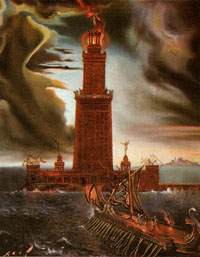Pharos of Alexandria
The Pharos of Alexandria, one of the Seven Wonders of the Ancient World was a huge lighthouse located on the island of Pharos in the city of Alexandria. When Alexander the Great laid out the city he connected the island of Pharos with the mainland by means of a dike giving the city a double harbor. His successor Ptolemy I of Egypt (d. 284BC) started the construction of a white marble lighthouse and his successor Ptolemy II completed the project.
The structure was completed in three stages. The first was square, the second was octagonal and the third was circular. In order to get to the entrance one had to walk up a long vaulted ramp and from there a spiral staircase led up to the many chambers. At its base was a 300-room fortress where soldiers could fight off approaching foe. When completed, the lighthouse was more than 400ft. high.
At the top of the tower, a bonfire of resinous wood or oil burned continuously at night making the fire visible for as far as 30 miles. Some historians have questioned the fire burning with wood in a land with few trees. By day metal mirrors supposedly designed by Archimedes, reflected sunlight. Legend tells how the mirror was used to burn enemy ships before they could reach seashore.
Several images of the lighthouse have been found on ancient coins, terracottas and mosaics but ancient writers have not left much detail. The beacon was built to guide seaman to refuge as they approached the coast of Egypt. The Pharos of Alexandria became the model for ancient lighthouses. The architect Sostratus dedicated it to the savior gods on behalf of the navigators.
Arabs thought gold was hidden inside so they destroyed part of it in their search for more wealth. When they conquered Egypt they wrote about the city of Alexandria and all of its wealth. In 796 the lighthouse lost its upper level due to an earthquake. In 1261 another earthquake struck destroying more masonry. In 1272 sultan Salah el din (Saladin) ordered restoration work for the damaged pharos. Then, on August 8, 1303 a powerful earthquake shook the eastern Mediterranean basin and released the majestic lighthouse into the torrid sea.
In 1349 the famous Arab traveler Ibn Battuta visited Alexandria. He wrote that he was unable to even climb to the doorway for the Pharos was in such smashed ruins. In 1480 the Egyptian sultan Qaitbay built a medieval fort on the exact site where the lighthouse once stood using the toppled stone and marble. The ancient island of Pharos is now a cape within the city of Alexandria in Egypt. The majestic lighthouse, the Pharus of Alexandria was the last of the seven wonders to disappear.
